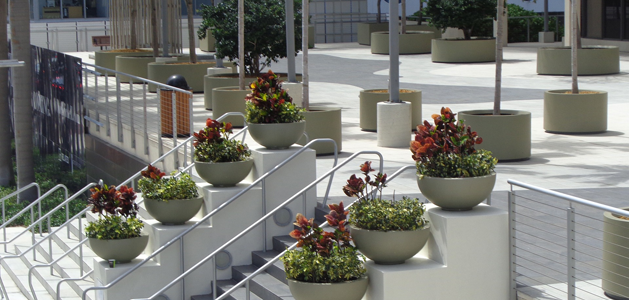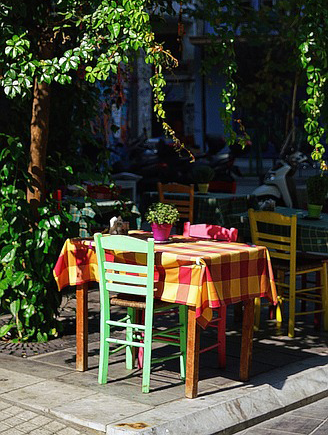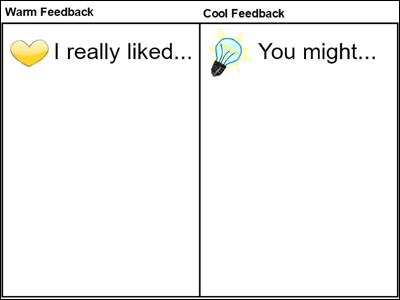
Use a tactical urbanism approach to revitalize and connect your community

Cities and towns around the world are creating pop-up parks and pedestrian plazas to create positive change in their communities. These low-cost short term projects are part of a tactical urbanism movement that uses low-cost materials and temporary designs to collect data, experiment, and promote long term change.
In this project, students will identify a small unused space in their neighborhood or around their school and design a proposal to transform it into a pop-up space that encourages classmates and community members to relax, reflect and connect.
Ask students if they have ever visited a pop-up store or browsed for a new book at a Little Free Library®. They may also remember when many restaurants took over outdoor parking lots and sidewalks for additional outdoor seating during the COVID 19 pandemic.
Discuss with your students how they felt about these changes, spaces, and opportunities when they experienced them.

These are examples of "tactical urbanism" or tactics used to improve the urban environment. A tactical urbanist makes small, low-cost changes quickly to try out an idea or adapt to community needs.
Inform students they will be developing a proposal that showcases how a space in their neighborhood can be transformed into a pop-up park or plaza that better serves the people in the community.
To prepare for the assignment, have students explore parks and plazas in their neighborhood. Or, if possible go a field trip and have students take pictures of videos of possible locations. Ask students to keep in mind which features may encourage people to:
Work together to craft a list of features of community spaces that make them attractive and useful to community members.
Before jumping into their designs, watch Amanda Burden's TED Talk on How public spaces make cities work and explore examples of tactical urbanism projects around the world.
You may also want to provide materials to help students learn more about how architectural designers use space and features to connect people to spaces.
The process of creating and designing a pop-plaza isn't something a single student can do in one class period, or even a week. Students will need to work together to complete a successful pop-up park proposal. You can group students into teams ahead of time or group them based on interest, which means you may have to have students working individually at the beginning and then finding connections to space and ideas as they arise.
The first step in the process is figuring out what spaces in your community might work. Students may have already found locations if you went on a neighborhood walk. They may also be able to spot locations using the satellite view in a maps program.
Once a location has been chosen, students need to capture data about the location. This can be as simple as measuring perimeter and area, but can also include designing a scale model of the space that also indicates the location of permanent features like trees, hydrants, and concrete.
While students can certainly get started designing whatever they think should be added to the space, encourage them to also interview people who live in or near the location to get a better understanding of their needs and desires for their community.
Stakeholder interviews help the designers learn what pop-up park users might be interested in seeing and doing at the space and craft a proposal that is more useful to the community. Interviews can help designers consider questions like:
Once students have collected details of the space and recorded the interests of the community, they are ready to imagine possibilities for the space. Teams should brainstorm possibilities first and then look at their list to see what is both affordable and feasible.
Teams can take their area models and add in potential features to help the community better understand their vision. They may also want to create a list of materials and costs. These can combine with a written proposal that might address:
Before making their pitch to civic stakeholders, have student teams first pitch their proposals to "critical friends" in your classroom. Use this opportunity to ask clarifying questions, prompt thinking in new directions, and motivate students to make changes. You can use a warm and cool feedback organizer to prompt student thinking as they watch the pitches and provide suggestions.

Download a Warm and Cool Feedback sheet page
After sharing and receiving feedback, teams should make tweaks to the design and edits to their presentation.
Students want to do real work, so their pitch should be to your local community, including government agencies, city council members, neighborhood associations, and the people who live nearby. Be sure to contact these people before you begin and maybe even bring these stakeholders in during the process to share their process and requirements. This would allow them to become aware of your process and requirements and participate in evaluating student work.
Have a formal event where the designs are unveiled and presented. You may choose to invite participants to your school auditorium or multi-purpose room or visit a community space (library or cafe) to have students share their ideas.
Encourage students to include visuals, such as maps, design prototypes and even marketing materials to better pitch their design proposals.
Since realizing their designs will be the most powerful motivators for students, see if one of the community or civic leaders participating or evaluating your students can fund one or more of their projects.
The pop-up plaza proposal provides a summative performance assessment you can use to evaluate student knowledge about their community as well as their ability to use that information to persuade.
Check in with students as they complete notes from their research and stakeholder interviews. This will provide insight into the direction students are heading with their proposal and allow you to identify misconceptions they may have before they start writing (formative).
Have students share their presentations with you, and another team, before final group presentations so they can get ample feedback.
Create and share a rubric or checklist to clarify research, argument, and design expectations. While it is more time intensive, working with your class to create a rubric or checklist transfers responsibility for learning and gives students ownership of the assessment criteria.
Remember, success can be evaluated in many ways. Having students involved in a project focused on tactical urbanism not only prompts students to take action in their communities, but also creates a sense of pride and accomplishment in making their world a better place.
Mike Lydon and Anthony Garcia. Tactical Urbanism: Short-term Action for Long-term Change. ISBN: 1610915267
TED Talk - Amanda Burden: How public spaces make cities work
Principles for Designing Great Public Spaces
11 Rules to Follow When Creating Vibrant Public Spaces
Text Type and Purpose
1. Write arguments to support claims in an analysis of substantive topics or texts using valid reasoning and relevant and sufficient evidence.
2. Write informative/explanatory texts to examine and convey complex ideas and information clearly and accurately through the effective selection, organization, and analysis of content.
Production and Distribution of Writing
4. Produce clear and coherent writing in which the development, organization, and style are appropriate to task, purpose, and audience.
5. Develop and strengthen writing as needed by planning, revising, editing, rewriting, or trying a new approach.
6. Use technology, including the Internet, to produce and publish writing and to interact and collaborate with others.
Presentation of Knowledge and Ideas
4. Present information, findings, and supporting evidence such that listeners can follow the line of reasoning and the organization, development, and style are appropriate to task, purpose, and audience.
Dimension 1: Developing Questions and Planning Inquiries
5.6-8. Determine the kinds of sources that will be helpful in answering compelling and supporting questions, taking into consideration multiple points of views represented in the sources.
5.9-12. Determine the kinds of sources that will be helpful in answering compelling and supporting questions, taking into consideration multiple points of view represented in the sources, the types of sources available, and the potential uses of the sources.
Dimension 2: Civic and Political Institutions
D2.Civ.10.6-8. Explain the relevance of personal interests and perspectives, civic virtues, and democratic principles when people address issues and problems in government and civil society.
D2.Civ.10.9-12. Analyze the impact and the appropriate roles of personal interests and perspectives on the application of civic virtues, democratic principles, constitutional rights, and human rights.
D2.His.5.6-8. Explain how and why perspectives of people have changed over time.
D2.His.5.9-12. Analyze how historical contexts shaped and continue to shape people’s perspectives.
Dimension 4: Communicating and Critiquing Conclusions
D4.3.6-8. Present adaptations of arguments and explanations on topics of interest to others to reach audiences and venues outside the classroom using print and oral technologies (e.g., posters, essays, letters, debates, speeches, reports, and maps) and digital technologies (e.g., Internet, social media, and digital documentary).
D4.3.9-12. Present adaptations of arguments and explanations that feature evocative ideas and perspectives on issues and topics to reach a range of audiences and venues outside the classroom using print and oral technologies (e.g., posters, essays, letters, debates, speeches, reports, and maps) and digital technologies (e.g., Internet, social media, and digital documentary).
4. Innovative Designer
Students use a variety of technologies within a design process to identify and solve problems by creating new, useful or imaginative solutions. Students:
a. know and use a deliberate design process for generating ideas, testing theories, creating innovative artifacts or solving authentic problems.
6. Creative Communicator
Students communicate clearly and express themselves creatively for a variety of purposes using the platforms, tools, styles, formats and digital media appropriate to their goals. Students:
a. choose the appropriate platforms and tools for meeting the desired objectives of their creation or communication.
d. publish or present content that customizes the message and medium for their intended audiences.
7. Global Collaborator
Students use digital tools to broaden their perspectives and enrich their learning by collaborating with others and working effectively in teams locally and globally. Students:
b. use collaborative technologies to work with others, including peers, experts or community members, to examine issues and problems from multiple viewpoints.
c. contribute constructively to project teams, assuming various roles and responsibilities to work effectively toward a common goal.

Follow us on Instagram for daily inspiration

Create a thought web, cluster, flowchart, or other graphic organizer for a lesson
8 first projects to get students using technology
Creative, digital book reviews
Fun and powerful ideas with animated characters

Wixie
Share your ideas, imagination, and understanding through writing, art, voice, and video.

Rubric Maker
Create custom rubrics for your classroom.

Pics4Learning
A curated, copyright-friendly image library that is safe and free for education.

Wriddle
Write, record, and illustrate a sentence.

Get creative classroom ideas delivered straight to your inbox once a month.
Topics